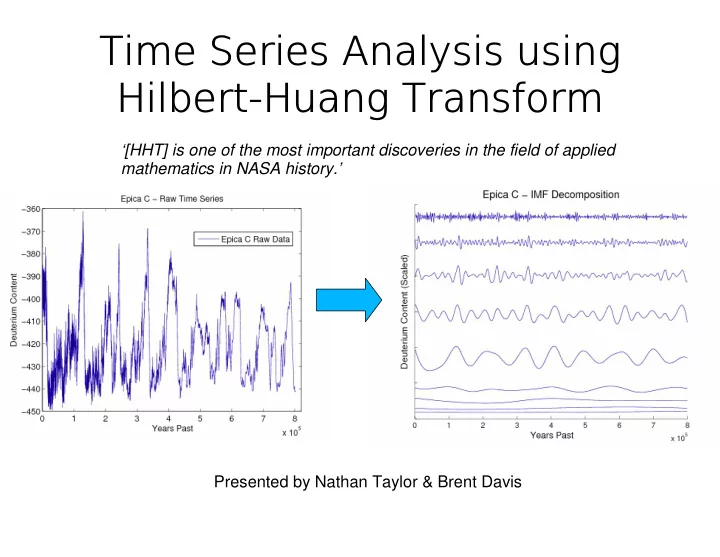

Time Series Analysis using Hilbert-Huang Transform ‘[HHT] is one of the most important discoveries in the field of applied mathematics in NASA history.’ Presented by Nathan Taylor & Brent Davis
Terminology Hilbert-Huang Transform (HHT) Empirical Mode Decomposition (EMD) Ensemble Empirical Mode Decomposition (EEMD) Intrinsic Mode Function (IMF) Empirical – Relying on derived from observation or experiment Mode – A particular form, variety, or manner Decomposition – The separation of a whole into basic parts Intrinsic – Belonging naturally
Computing the high frequency IMF � Find all local maxima of TS � Find all local minima of TS � Fit a curve through maxima � Fit a curve through minima � Find the mean of these two curves
Sifting: Subtract mean from Original Time Series Subtract the mean from original TS The goal is after a number of siftings, to minimize the mean
Repeat this process of sifting Three Notes: The mean will approach zero. The two envelopes are becoming more symmetric.
After multiple siftings Q: What property does it have? The mean is now minimized, so we would like to develop a stopping criterion a) b) The number of extrema and zero crossings are alternating.
EPICA C Ice Core IMF 1 The first IMF should have the highest frequency component.
Decomposing TS after multiple siftings Residual + IMF1 = Original TS, Residual = Original TS – IMF1 . . . Trend = Original TS – (IMF1 + IMF2 + … + IMFN)
About the trend An application of EMD is to find a empirical trend line. The trend shouldn't have periodic behavior Here's the last IMF and original TS
What is mode mixing? Cubic spline are not perfect if envelopes are close together and at a height away from zero Each IMF should have a dominant signal. Rather than get clean IMF signals there are combinations of frequencies
Explanation of EEMD Ensemble - A unit or group of complementary parts that contribute to a single effect. Outline: � Add white noise to original TS � Create a set of IMFs using EMD � Do this N times � Take the average of each individual IMF Result: New set of IMFs with less mode mixing
EMD
EEMD with 500 iterations
� Nonlinear � Nonstationary (mean, variance are functions of time � Local (frequency is a function t) � Adaptive FFT Frequency Power Spectrum: Mathematical artifacts occur when you assume linear, stationary, global, and/or nonadaptive
Analysis of each IMF
Mathematical Artifacts of Time Series Analysis using HHT Spacing: -Even vs. Uneven -Length of spacing Curve Fitting: -Cubic Spline vs. Linear Interpolation Level of white noise added We'll use the Vostok & Epica C Ice Core Data for examples
Uneven versus Even Spacing – IMF 8 Notice the EEMD on the evenly spaced data pulls out a more uniform signal
EMD v. EEMD – Cubic Spline IMF 8 Notice the EEMD pulls out a more uniform signal
Linear Interpolation v. Cubic Spline – IMF 6 The cubic spline and the linear interpolation return almost the exact same signal
Choices in Length of Spacing – IMF 6 The difference in spacing has little effect on the signal pulled out.
Varying Levels of Noise Notice the decompositions with higher levels of noise pull out a more uniform signal.
An Application of EEMD to Paleoclimatology Paleoclimatology is the study of climate change on a long time scale typically using a proxy measurement. We looked at two: EPICA C Ice Core Data Measures Deuterium Content
Noise of 0.5 Ensemble of 500 IMF 3 IMF 4 IMF 5
Welch Power Spectrum and Mean Periods of IMFs Notice there are three noticeable peaks in each 100,000 year 40,000 year 20,000 year cycle? cycle? cycle?
Milankovitch cycles: The earth axis completes one full cycle of precession every 26,000 years. The angle between Earth's rotational axis and the normal to the plane of its orbit, its obliquity, completes a full cycle every 41,000 years. The eccentricity is a measure of the departure of this ellipse from circularity Which combines to an approximate 100,000 year full cycle.
The angle between Earth's rotational axis and the normal to the plane of its orbit, its obliquity, completes a full cycle every 41,000 years.
Epica C Correlation Results for Obliquity & IMF 4 Lag results: 6,820 years ahead yields 0.6964 Choice: If the obliquity is a forcing function with which the earth responds, then the lag is 6,820 years ahead.
Correlation between IMF 4 and Obliquity without lag: coefficient: 0.3444 significance: 0.6220 with lag: coefficient: 0.6954 significance: 1.0000
The eccentricity is a measure of the departure of this ellipse from circularity which combines to an approximate 100,000 year full cycle.
Correlation between IMF 5 and Eccentricity coefficient: 0.5992 significance: 0.9940
The earth axis completes one full cycle of precession every 26,000 years.
Epica C Correlation Results for Climatic Precession & IMF 3 Lag results: 16,368 years ahead yields 0.4225 Choice: If the precession is a forcing function with which the earth responds, then the lag is 16,368 years ahead.
Correlation between IMF 3 and Climatic Precession without lag: coefficient: -0.164 significance: 0.35 with lag: coefficient: 0.4225 significance: 0.9100
Recommend
More recommend